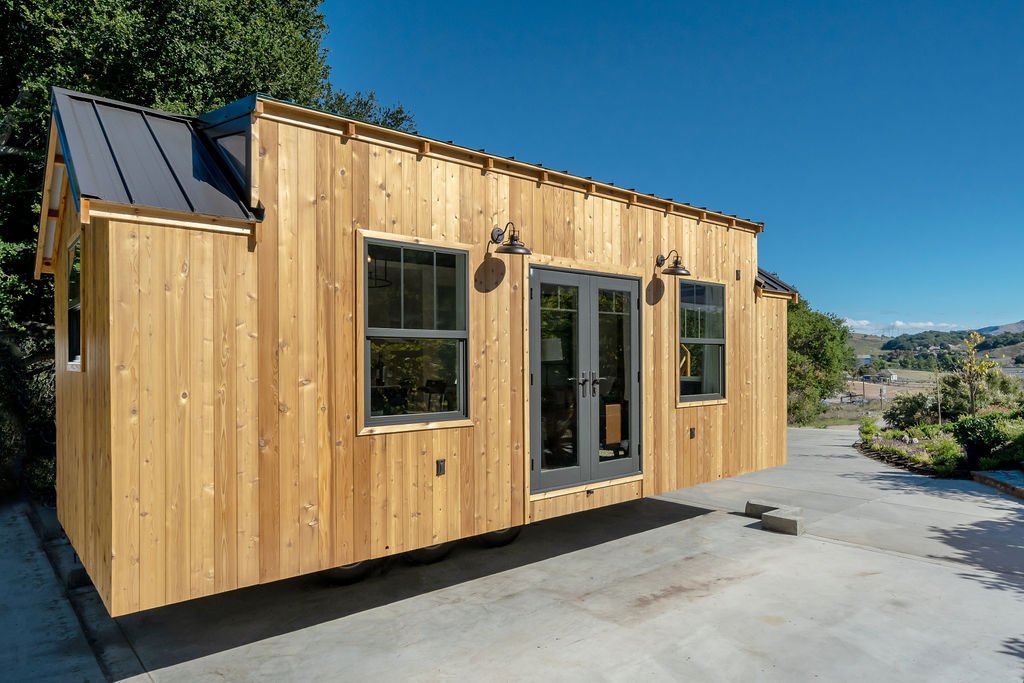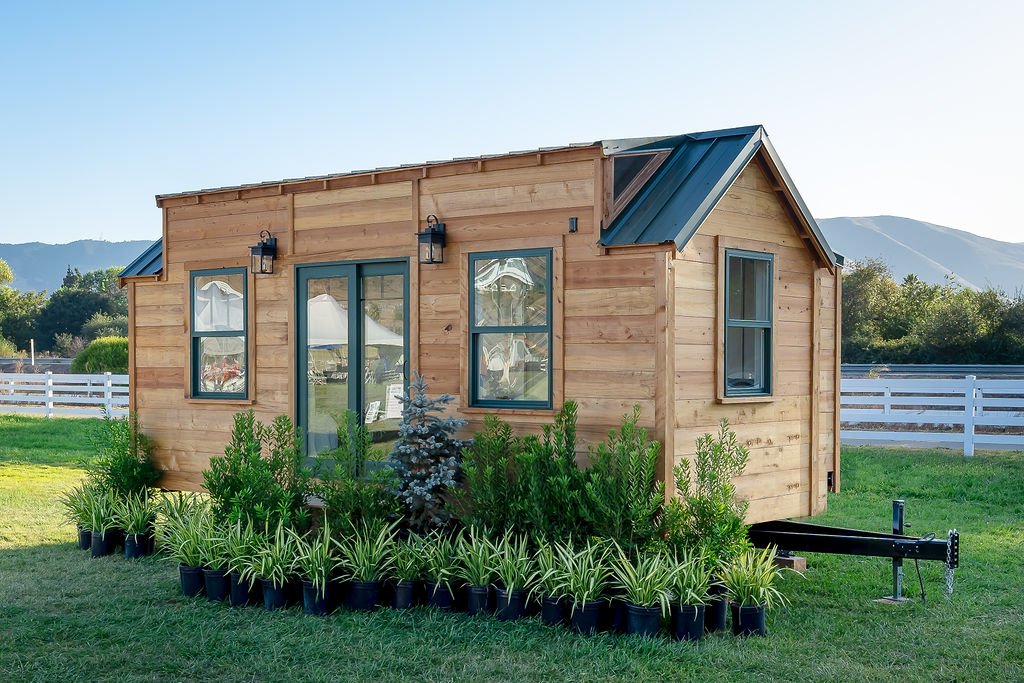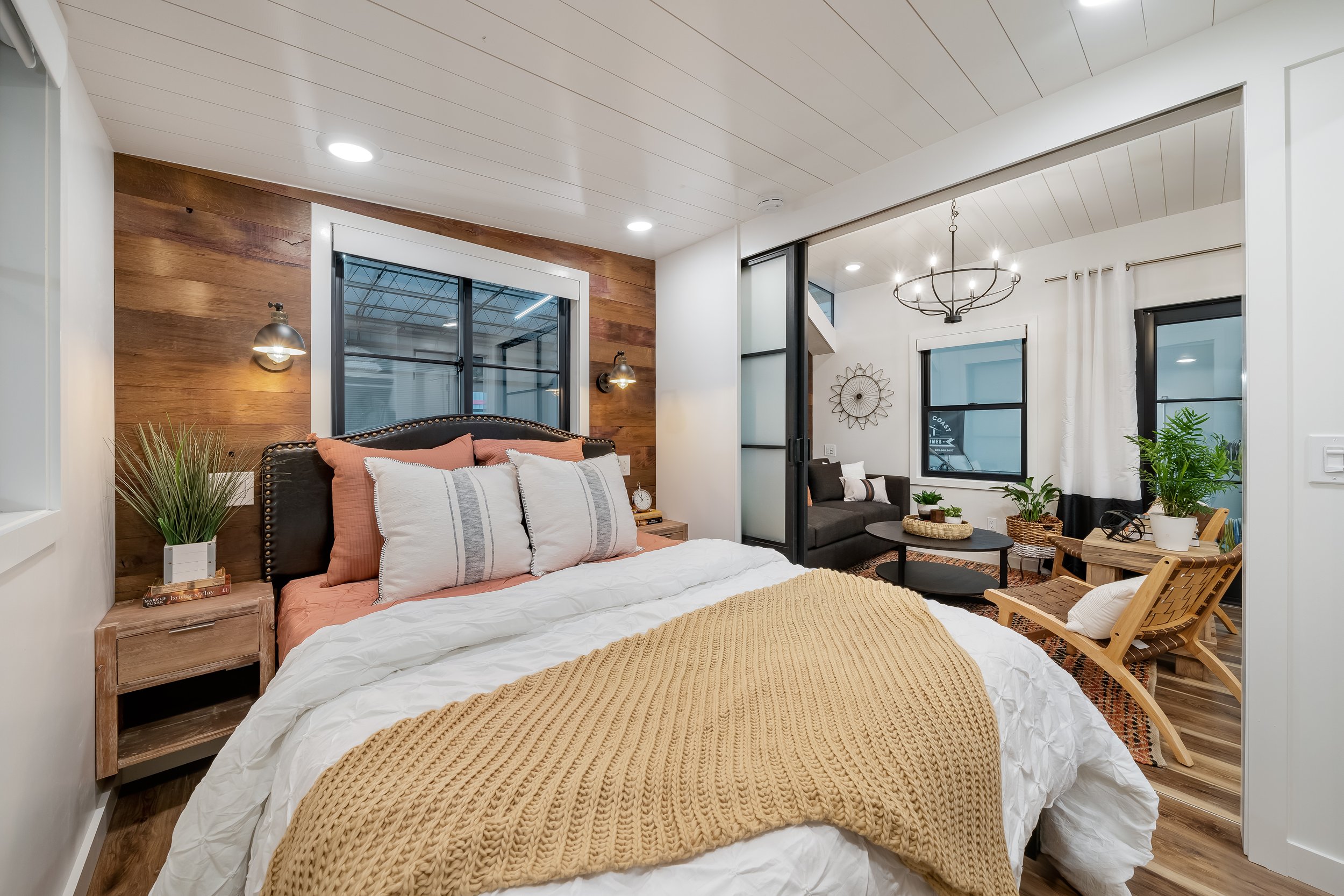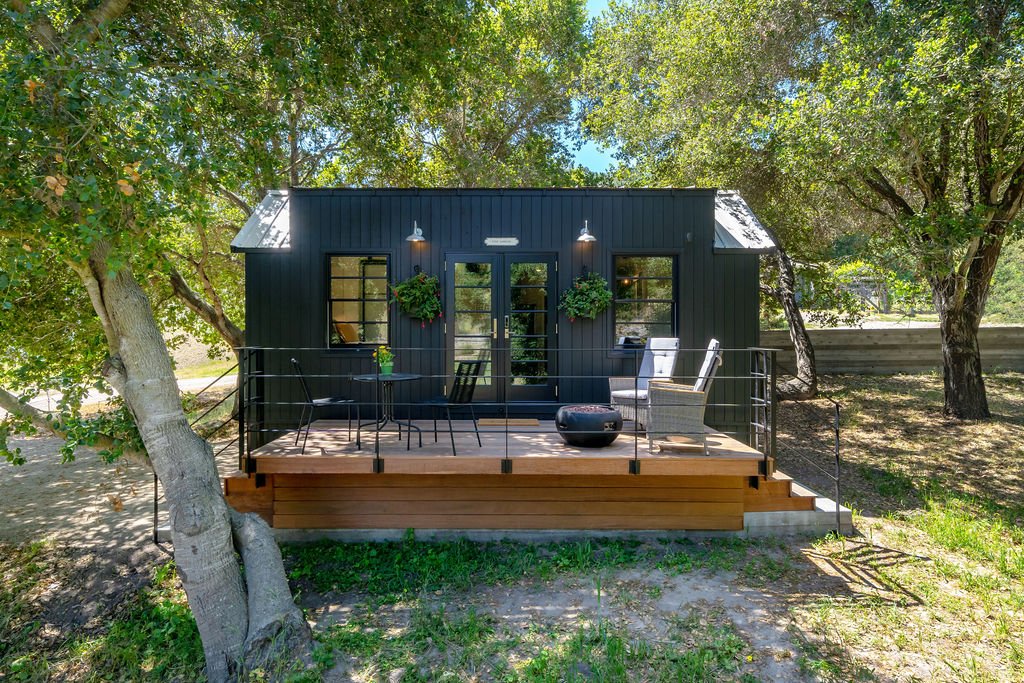Frequently Asked Questions
What is a Tiny Home on Wheels?
A Tiny Home On Wheels (THOW), sometimes called Moveable Tiny Home, is a form of Recreational Vehicle (RV). It cannot exceed 400 square feet as this would push it into the classification of Mobile Home or Manufactured Home with different regulations.
Where can I park my Tiny House?
A THOW can be parked in many RV parks and Mobile Home Parks. Check with your specific parks regarding their rental rates, rules and requirements.
A THOW can be parked on private property in some jurisdictions. See below regarding Building Permits.
What does a Tiny Home parking space require?
A THOW is like an RV but without any storage tanks or independent power supply. Therefore, it needs a firm space to park on. Our homes require the space to be approximately 25 feet square to accommodate the home and access stairs. That can be compacted road base, decomposed granite, asphalt, concrete, pavers, etc. In addition, access by way of stairs or ramp to a deck is needed. A deck height of approximately 32 inches works best for our homes.
It also requires utilities. Fresh water in the form of a hose spigot, a 50 amp RV style outlet, and a 3 inch sewer connection. Propane or natural gas connections are optional.
Where do I find Parking Spaces for Tiny Homes?
RV and Mobile home parks can be found through internet searches. Amenities, rates and rules vary, so contact directly specific parks of interest.
For spaces on private property, online bulletin boards such as Craigslist and Facebook Market are good options. Check the “Parking and Storage” sections. Again, rates and conditions vary. Keep in mind, as noted above regarding Permits, living in a THOW on these spots may not be a “permitted” use and you could be forced to move should the building authorities decide to intervene. Take this into account in signing any lease.
Another option is placing an advertisement on these online boards. A picture of your tiny home along with a description of yourself and what you are willing to pay is helpful. The potential landlord may not have utilities installed. Therefore, you may have to negotiate who pays the costs to get those installed.
Does a Tiny Home on Wheels require a Building Permit?
In most cities and counties, THOWs are treated the same as RVs. That means that no building permits are issued or needed to park a THOW on one’s property. HOWEVER, it is likely not a “permissible use” to live in a THOW or RV beyond a limited number of days—typically 28 – 90 days. Though many people do live in them, they are doing so in contradiction to local regulations.
In many places, the authorities tolerate people living in THOWs SO LONG AS there are no complaints from neighbors or safety hazards. We suggest potential Tiny Home buyers check with their local planning department to determine their policies regarding THOWs and code enforcement. In addition, we suggest checking with surrounding neighbors regarding how they might respond to a THOW parked nearby.
Is a tiny home an ADU?
A limited number of jurisdictions have recognized that THOWs are different from RVs in that they are constructed for full-time living and are more aesthetically pleasing than RVs. Therefore, they have passed regulations and issue permits allowing THOWs for full time living as ADUs. Typically, they are only permitted as Accessory Dwelling Units (ADUs). This means there must be a Primary Permanent Dwelling Unit on the property to which the THOW serves as an ADU. There are a very limited number of jurisdictions that allow THOWs as primary residences on private property.
How does a tiny home get delivered?
Central Coast Tiny Homes typically provides delivery and installation with our homes. Most other manufactures offer assistance in arranging delivery through a third party trucking company. Customers may pick up their homes from the manufacturer themselves provided they have a vehicle capable of the job.
Financing Your Tiny Home
Tiny homes can be an affordable housing option. However, they are not necessarily simple option. The first obstacle to overcome is finding a location to park and live in your tiny home. See above. The second obstacle, covered here, is financing your tiny home. Though tiny homes are classified as recreational vehicles (RV), they are not as easy to finance as a traditional RV or Park Model RV. In order to underwrite loans, banks want to know the market value, both new and used, of the RVs they are financing. Like with auto loans, an underwriter can easily look up the value of a traditional new or used RV in the industry’s version of the Blue Book or NADA guide. Tiny homes, on the other hand, are very customized and build by small builders with low volumes. Thus, finding comparable homes on which to assess value is extremely difficult. As a result, there are few banks offering tiny house loans. 21st Mortgage is one such option.
Unsecured personal loans may be available to some buyers but interest rates are high and amounts available may not be enough for the $100,000 to $200,000 home you are dreaming about.
For property owners, a home equity line of credit (HELOC) can be the easiest and most economical choice. Paperwork is often minimal and rates very low.
Because tiny homes are considered RVs, they are supposed to be registered with the Department of Motor Vehicles. Sales tax on your tiny home must be paid at the time of registration. Those taxes can easily reach as much as $10,000 or more on a $150,000 tiny home. Therefore, many tiny home buyers who have no intention of moving their unit frequently forgo registration and avoid the expense. However, any bank offering tiny house loans will require the home to be registered as this provides the bank with the title papers (pink slip) until the loan has been paid off. When weighed against the added expense of registration, a personal loan or HELOC may prove to be a better choice.
Tiny Homes from Walmart
Maybe you’ve heard that Walmart (and Amazon) are selling tiny homes for under $10,000. You then looked it up and the pictures are very attractive. Too good to be true?
Let’s look a little deeper. The first thing to take note of is the fine print. They often include the phrase “Price is not final.” Or it will indicate that only the “basic structure” is included.
So what do you get for your $10,000? What you’ll find is that the package includes only the “shell”. A shell means a watertight structure to be assembled on top of the foundation you installed at your site (add $500 - $4000). You’ll also need to bring utilities ($500 - $4000+).
Assuming the exterior of the shell is “complete”: meaning roofing, windows, exterior siding, and paint are included, you are now ready to start finishing out the inside. You will be adding interior walls ($500 - $2000), plumbing ($500-$3000), electrical ($500-$3000), insulation ($500-$2000), interior wall surfaces ($500-$2000), flooring ($500-$2000), cabinets ($500-$4000), finish plumbing & electrical ($500-$3000), appliances ($1000-$6000) etc.
That $10,000 shell is now possibly a livable tiny home at $15,000 - $40,000.
So why are tiny home companies charging $80,000 to $200,000? Great questions.
The $40,000 above is for a very minimalist tiny home that you build yourself on the ground. A tiny home on wheels (THOW) is on a trailer ($5000 - $25,000). If you want a more customized house with high quality materials, you will have additional costs ($30,000). That adds up to approximately $55,000 to $75,000 in materials.
Add professional labor ($30,000 - $50,000) and overhead ($8,000) and the home now costs $90,000 - $130,000. And of course, the builder needs to make a profit from the business.
Clearly, it is possible to build your own tiny home for a very low price and it can be an extremely rewarding experience. However, you will need the time (400 – 800 hours or more depending on your skills), the tools, and the space. Assuming you have all of that, it would be wise to do some internet searches on DIY horror stories.
Central Coast Tiny Homes is happy to assist you in your tiny house journey.
Tiny Home as Investment
Real estate has been a tried-and-true investment since investing began. Not only can it generate rental income and tax deductions, but a well-chosen property will increase in value over time. Will Tiny Homes on Wheels (THOWs) generate the same returns? Yes and no.
Yes, THOWs can bring a great return on investment through rental income. Though not installed on a foundation, a quality THOW can earn similar rents with a much smaller initial investment. Assuming the buyer already owns the land where the home will be placed, the cost for the tiny home and infrastructure can range from $75,000 to $250,000 depending on quality and the particulars of the location.
Let’s assume a high-quality tiny home ($160,000) and modest infrastructure requirements such as gravel driveway, utility connections to an existing home, and a deck/access stairway ($15,000). In San Luis Obispo County a 400 square foot one bedroom could garner $2,000/month or more. That would be a 13% gross return on investment. Used as a short-term vacation rental in a desirable location, that return could triple or quadruple AFTER expenses.
No, a Tiny Home on Wheels will not increase in value like real property, nor will it add to the market value of its host property. Because it can be easily removed, it is considered personal property rather that real property. And like other personal property (RVs, cars, etc) it is likely to decrease in value over time.
We, at Central Coast Tiny Homes, encourage buyers to think of THOWs as fulfilling a specific need such as housing or income/cash flow rather than an appreciating investment. That said, a tiny home with a modest 20 year life can bring in between $400,000 and $1,000,000.






